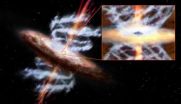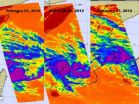(Press-News.org) A curious correlation between the mass of a galaxy's central black hole and the velocity of stars in a vast, roughly spherical structure known as its bulge has puzzled astronomers for years. An international team led by Francesco Tombesi at NASA's Goddard Space Flight Center in Greenbelt, Md., now has identified a new type of black-hole-driven outflow that appears to be both powerful enough and common enough to explain this link.
Most big galaxies contain a central black hole weighing millions of times the sun's mass, but galaxies hosting more massive black holes also possess bulges that contain, on average, faster-moving stars. This link suggested some sort of feedback mechanism between a galaxy's black hole and its star-formation processes. Yet there was no adequate explanation for how a monster black hole's activity, which strongly affects a region several times larger than our solar system, could influence a galaxy's bulge, which encompasses regions roughly a million times larger.
"This was a real conundrum. Everything was pointing to supermassive black holes as somehow driving this connection, but only now are we beginning to understand how they do it," Tombesi said.
Active black holes acquire their power by gradually accreting -- or "feeding" on -- million-degree gas stored in a vast surrounding disk. This hot disk lies within a corona of energetic particles, and while both are strong X-ray sources, this emission cannot account for galaxy-wide properties. Near the inner edge of the disk, a fraction of the matter orbiting a black hole often is redirected into an outward particle jet. Although these jets can hurl matter at half the speed of light, computer simulations show that they remain narrow and deposit most of their energy far beyond the galaxy's star-forming regions.
Astronomers suspected they were missing something. Over the last decade, evidence for a new type of black-hole-driven outflow has emerged. At the centers of some active galaxies, X-ray observations at wavelengths corresponding to those of fluorescent iron show that this radiation is being absorbed. This means that clouds of cooler gas must lie in front of the X-ray source. What's more, these absorbed spectral lines are displaced from their normal positions to shorter wavelengths -- that is, blueshifted, which indicates that the clouds are moving toward us.
In two previously published studies, Tombesi and his colleagues showed that these clouds represented a distinct type of outflow. In the latest study, which appears in the Feb. 27 issue of Monthly Notices of the Royal Astronomical Society, the researchers targeted 42 nearby active galaxies using the European Space Agency's XMM-Newton satellite to hone in on the location and properties of these so-called "ultra-fast outflows" -- or UFOs, for short. The galaxies, which were selected from the All-Sky Slew Survey Catalog produced by NASA's Rossi X-ray Timing Explorer satellite, were all located less than 1.3 billion light-years away.
The outflows turned up in 40 percent of the sample, which suggests that they're common features of black-hole-powered galaxies. On average, the distance between the clouds and the central black hole is less than one-tenth of a light-year. Their average velocity is about 14 percent the speed of light, or about 94 million mph, and the team estimates that the amount of matter required to sustain the outflow is close to one solar mass per year -- comparable to the accretion rate of these black holes.
"Although slower than particle jets, UFOs possess much faster speeds than other types of galactic outflows, which makes them much more powerful," Tombesi explained.
"They have the potential to play a major role in transmitting feedback effects from a black hole into the galaxy at large."
By removing mass that would otherwise fall into a supermassive black hole, ultra-fast outflows may put the brakes on its growth. At the same time, UFOs may strip gas from star-forming regions in the galaxy's bulge, slowing or even shutting down star formation there by sweeping away the gas clouds that represent the raw material for new stars. Such a scenario would naturally explain the observed connection between an active galaxy's black hole and its bulge stars.
Tombesi and his team anticipate significant improvement in understanding the role of ultra-fast outflows with the launch of the Japan-led Astro-H X-ray telescope, currently scheduled for 2014. In the meantime, he intends to focus on determining the detailed physical mechanisms that give rise to UFOs, an important element in understanding the bigger picture of how active galaxies form, develop and grow.
INFORMATION:
Ultra-fast outflows help monster black holes shape their galaxies
2012-02-29
ELSE PRESS RELEASES FROM THIS DATE:
Research sheds light on how immune system's 'first responders' target infection
2012-02-29
University of Texas Medical Branch at Galveston researchers have discovered previously unsuspected aspects of the guidance system used by the body's first line of defense against infection.
The new work focuses on the regulation of immune response by two forms of the signaling molecule IL-8, as well as IL-8's interaction with cell-surface molecules called glycosaminoglycans (or GAGs for short).
Infected or injured tissues release IL-8 to attract bacteria- and virus-killing white blood cells known as neutrophils, a process known as "recruitment." As IL-8 proteins disperse ...
Upper class more likely to be scofflaws
2012-02-29
The upper class has a higher propensity for unethical behavior, being more likely to believe – as did Gordon Gekko in the movie "Wall Street" – that "greed is good," according to a new study from the University of California, Berkeley.
"The increased unethical tendencies of upper-class individuals are driven, in part, by their more favorable attitudes toward greed," said Paul Piff, a doctoral student in psychology at UC Berkeley and lead author of the paper published today (Monday, Feb. 27) in the journal Proceedings of the National Academy of Sciences.
Piff's study ...
3 days of NASA infrared images show System 92S tropically developing
2012-02-29
NASA satellites have been watching the low pressure area called System 92S for days, and infrared imagery from NASA's Aqua satellite showed cloud temperatures were cooling, indicating the storm was getting more organized after it moved over northern Madagascar. Now it may be headed for landfall in Mozambique.
The Atmospheric Infrared Sounder (AIRS) instrument on NASA's Aqua satellite captured infrared imagery on developing System 92S as it moved from the Southern Indian Ocean, west across northern Madagascar and into the Mozambique Channel. On February 25 at 0941 UTC, ...
Hays Reports Tunnel Vision Trapping Workers and Hindering Growth
2012-02-29
The Hays Career Outlook Survey has revealed that workers are being trapped in career silos because they don't believe they can cross sector or industry boundaries, according to new data from the Hays Career Outlook Survey. The survey also highlights that employers in both sectors are often unable to recognise the transferable skills that might help them to identify potential candidates who are capable of supporting their growth plans.
The survey reveals the vast majority of employers believe that previous experience in the same sector is important. Whilst only just ...
Salty soil can suck water out of atmosphere: Could it happen on Mars?
2012-02-29
CORVALLIS, Ore. – The frigid McMurdo Dry Valleys in Antarctica are a cold, polar desert, yet the sandy soils there are frequently dotted with moist patches in the spring despite a lack of snowmelt and no possibility of rain.
A new study, led by an Oregon State University geologist, has found that that the salty soils in the region actually suck moisture out of the atmosphere, raising the possibility that such a process could take place on Mars or on other planets.
The study, which was supported by the National Science Foundation, has been published online this week ...
Modified bone drug kills malaria parasite in mice
2012-02-29
CHAMPAIGN, Ill. — A chemically altered osteoporosis drug may be useful in fighting malaria, researchers report in a new study. Unlike similar compounds tested against other parasitic protozoa, the drug readily crosses into the red blood cells of malaria-infected mice and kills the malaria parasite. The drug works at very low concentrations with no observed toxicity to the mouse.
The study appears in the Proceedings of the National Academy of Sciences.
The researchers found the drug by screening a library of about 1,000 compounds used in previous efforts to target an ...
Protocol reduces sternal wound infections in children by 61 percent
2012-02-29
SAN ANTONIO -- A two-year effort to prevent infections in children healing from cardiac surgery reduced sternum infections by 61 percent, a San Antonio researcher announced at the Cardiology 2012 conference Feb. 23 in Orlando, Fla.
Faculty from UT Medicine San Antonio carried out a new infection-control protocol for 308 children who underwent sternotomies at CHRISTUS Santa Rosa Children's Hospital between 2009 and 2011. UT Medicine is the clinical practice of the School of Medicine at The University of Texas Health Science Center San Antonio.
Approach to children ...
HFSA updates recommendations for use of cardiac resynchronization therapy
2012-02-29
Philadelphia, PA, February 27, 2012 – Based on a review of the latest evidence, the Guidelines Committee of the Heart Failure Society of America now recommends that the use of cardiac resynchronization therapy (CRT) be expanded to a larger group of patients with mild heart failure symptoms. Recommendations for integrating new evidence into clinical practice appear in the February issue of the Journal of Cardiac Failure.
CRT devices synchronize the function of the left ventricle so that it contracts more efficiently and in a coordinated way. It does this by stimulating ...
Guoman Hotels' The Grosvenor Hotel Victoria Uncovers the 'Courtesan's Boudoir'
2012-02-29
Guoman Hotels' The Grosvenor Hotel has revealed its past connection to one of the most risque residents of 1870s London, with the launch of its opulent 'Courtesan's Boudoir'. The Parisian-inspired Suite has been tenderly created in homage to one of the grand railway hotel's most infamous visitors - the scandalous courtesan, Miss Cora Pearl.
A lady notorious with entertaining only the highest members of social standing, including royalty, Cora Pearl was one of the most feted courtesans of her time. In the 1870s, Cora made a rare visit to London and, after arriving at ...
Land-ocean connections
2012-02-29
Scientists from the School of Ocean and Earth Science and Technology (SOEST) at the University of Hawaii – Manoa (UHM) and colleagues recently discovered that land-based plant material and coastal macroalgae indirectly support the increased abundances of bottom fish in submarine canyons, like those off the north shore of Moloka'i. Less than a few miles from the shore, these underwater canyons connect to deep river valleys that cut across the landscape of north Moloka'i. The high elevation and forested landscapes along Moloka'i's north shore provide plant material, including ...



